Papers by Terrence Forrester
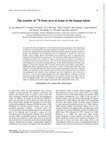
British Journal of Nutrition, May 1, 2000
To explore the nutritional significance of urea hydrolysis for human subjects, male infants being... more To explore the nutritional significance of urea hydrolysis for human subjects, male infants being treated for severe undernutrition were given oral doses of 10 mg [ 15 N 15 N]urea every 3 h for 36 h, on admission, during rapid growth and after repletion with either moderate or generous intakes of protein. Urea hydrolysis was calculated from the 15 N enrichment of urinary urea, and where possible, lysine, alanine, glycine and histidine were isolated from urine by preparative ionexchange chromatography for measurement of 15 N enrichment. Sufficient N was obtained for 15 N enrichment of lysine to be measured on fifteen occasions from six children. Urea hydrolysis accounted for half of all urea production with 130 (SD 85) mg N/kg hydrolysed per d, most of which appeared to be utilized in synthetic pathways. Of the samples analysed successfully, nine samples of lysine were enriched with 15 N (mean atom percent excess 0⋅0102, range 0⋅0017-0⋅0208) with relative enrichment ratios with respect to lysine of 1⋅63 (range 0⋅18-3⋅15), 1⋅96 (range 0⋅7-3⋅73) and 0⋅9 (range 0⋅4-1⋅8) for glycine, alanine and histidine respectively. Enriched samples were identified at each treatment phase and 68 % of the variation in lysine enrichment was explained by the variation in urea enrichment with 54 % explained by the overall rate of delivery of 15 N to the lower gastrointestinal tract. The results indicate a minimum of 4⋅7 mg lysine per kg body weight made available by de novo synthesis with the more likely value an order of magnitude higher. Thus, urea hydrolysis can improve the quality of the dietary protein supply by enabling an increased supply of lysine and other indispensable amino acids.
Applied Neuropsychology: Adult, Sep 27, 2022
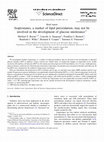
Diabetes Research and Clinical Practice, Apr 1, 2007
We investigated whether isoprostanes, as a marker of lipid peroxidation, may be involved in the d... more We investigated whether isoprostanes, as a marker of lipid peroxidation, may be involved in the development of impaired glucose tolerance (IGT) or diabetes. Using a nested case-control study, we tracked the changes in isoprostane levels, insulin sensitivity (IS) and beta-cell function (BCF) in Afro-Jamaicans who progressed to IGT and diabetes over 3.9 years. Anthropometry, glucose tolerance, insulin levels, blood pressure and urinary isoprostane concentration were measured at baseline and follow-up. IS and BCF were estimated by the method of homeostasis assessment. Fifty-two individuals who progressed to IGT or diabetes and 44 age, sex and body mass index (BMI) matched controls were studied. Progression to glucose intolerance was significantly related with baseline BCF ( p 0.01), but not isoprostane levels or IS. Glucose concentrations (fasting and 2 h) on follow-up were significantly correlated to baseline IS, baseline BCF, follow-up IS and follow-up BCF ( p-values < 0.05). In multiple regression analysis, only follow-up IS and BCF ( p-values 0.001) independently predicted fasting glucose and 2 h glucose levels at follow-up. Isoprostanes were not significantly associated with IS or BCF ( pvalues > 0.1). We concluded that isoprostanes may not be causally involved in the development of glucose intolerance, insulin resistance or deteriorating BCF.
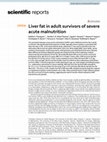
Scientific Reports, 2022
The association between severe acute malnutrition (SAM) in early childhood and liver fat in adult... more The association between severe acute malnutrition (SAM) in early childhood and liver fat in adults is unknown. We hypothesized that exposure to SAM, especially severe wasting, is associated with fatty liver later in life. In this observational study, abdominal CT was used to quantify mean liver attenuation (MLA) and liver:spleen attenuation ratio (L/S). Birth weight (BW), serum lipids, insulin resistance (homeostatic model assessment), anthropometry and intrabdominal fat were collected. Mean differences between diagnostic groups were tested and hierarchical regression analysis determined the best predictors of liver fat. We studied 88 adult SAM survivors and 84 community participants (CPs); age 29.0 ± 8.4 years, BMI 23.5 ± 5.0 kg/m2 (mean ± SDs). SAM survivors had less liver fat than CPs (using L/S) (p = 0.025). Severe wasting survivors (SWs) had lower BW (-0.51 kg; p = 0.02), were younger, thinner and had smaller waist circumference than oedematous malnutrition survivors (OMs). In ...
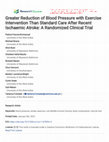
Context and Objectives: Ischaemic stroke (IS) causes disability and uses massive public health re... more Context and Objectives: Ischaemic stroke (IS) causes disability and uses massive public health resources. Cumulative disability from recurrence may be reduced with cardiometabolic risk reduction strategies e.g., lowering blood pressure (BP). We hypothesized that intensive exercise plus best available care in adults with recent IS improves fitness, glucose metabolism, muscle protein synthesis in paretic limbs compared to controls. BP changes were compared between intervention (INT) and controls (CON). Research Design and Setting: A randomised, interventional clinical trial conducted in Jamaican adults subjects: We investigate 103 adults with recent IS and residual weakness. Forty-nine subjects (24 women: mean age 61.5; 25 men: mean age 63.8) received task-oriented exercise training (TEXT) plus best available care. Fifty-four subjects (23 women: mean age 60.2; 31 men: mean age 61.3) received best care, including exercise advice. Measurements: We measured baseline, 3-month and 6-month ...
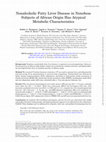
Journal of the Endocrine Society, 2019
BackgroundNonobese nonalcoholic fatty liver disease is reported in several populations. However, ... more BackgroundNonobese nonalcoholic fatty liver disease is reported in several populations. However, because persons of African origin display unique fat accumulation, insulin resistance, and lipid profiles, we investigated fatty liver in nonobese persons of African origin.MethodWe recruited 78 urban Jamaican volunteers. CT was used to estimate liver and abdominal fat and dual-energy X-ray absorptiometry to measure body composition. Fasting blood was collected for lipids, alanine aminotransferase (ALT), adiponectin, and fetuin-A. Homeostatic model assessment of insulin resistance (HOMA-IR), whole-body insulin sensitivity index (WBISI), insulinogenic index (IGI), and oral disposition index (oDI) were calculated after a 75-g oral glucose tolerance test.ResultsFifty-two percent of participants were male; mean (±SD) age was 28.5 ± 7.8 years, and body mass index was 22.4 ± 3.0 kg/m2. Mean liver attenuation (MLA) and liver/spleen (LS) ratio, both inversely correlated to liver fat, were 62.8 ±...
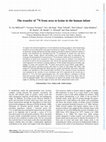
British Journal of Nutrition, 2000
To explore the nutritional significance of urea hydrolysis for human subjects, male infants being... more To explore the nutritional significance of urea hydrolysis for human subjects, male infants being treated for severe undernutrition were given oral doses of 10 mg [15N15N]urea every 3 h for 36 h, on admission, during rapid growth and after repletion with either moderate or generous intakes of protein. Urea hydrolysis was calculated from the15N enrichment of urinary urea, and where possible, lysine, alanine, glycine and histidine were isolated from urine by preparative ion-exchange chromatography for measurement of15N enrichment. Sufficient N was obtained for15N enrichment of lysine to be measured on fifteen occasions from six children. Urea hydrolysis accounted for half of all urea production with 130 (sd 85) mg N/kg hydrolysed per d, most of which appeared to be utilized in synthetic pathways. Of the samples analysed successfully, nine samples of lysine were enriched with15N (mean atom percent excess 0·0102, range 0·0017–0·0208) with relative enrichment ratios with respect to lysin...
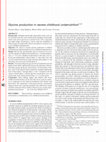
The American Journal of Clinical Nutrition, 2006
Background: Although nutritionally dispensable amino acids are not essential in the diet, from a ... more Background: Although nutritionally dispensable amino acids are not essential in the diet, from a biochemical standpoint, dispensable amino acids such as glycine are essential for life. This is especially true under unique circumstances, such as when the availability of labile nitrogen for dispensable amino acid synthesis is reduced, as in severe childhood undernutrition. Objective: We aimed to measure glycine production in children with edematous and nonedematous severe childhood undernutrition. Design: Glycine flux and splanchnic glycine extraction were measured in 2 groups of children with edematous (n ҃ 8) and nonedematous (n ҃ 9) severe childhood undernutrition when they were infected and malnourished (clinical phase 1), when they were still severely malnourished but no longer infected (clinical phase 2), and when they were recovered (clinical phase 3). Results: Total and endogenous glycine flux and splanchnic glycine uptake did not differ significantly between the edematous and nonedematous groups during any clinical phase. In both groups of subjects, none of the glycine kinetic parameters changed significantly from clinical phase 1 through phases 2 and 3. Compared with the value at clinical phase 3, plasma glycine concentrations were not significantly lower during clinical phase 1 or 2 in either group. Conclusions: These findings suggest that children with severe childhood undernutrition can increase their de novo glycine synthesis to compensate for the reduced contribution from chronic food deprivation. The maintenance of the plasma glycine concentration suggests that the rate of glycine production was sufficient to satisfy metabolic demands in these children when they were acutely undernourished and infected.
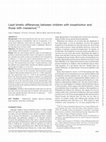
The American Journal of Clinical Nutrition, 2006
Background: It has been hypothesized that one factor associated with poor prognosis in kwashiorko... more Background: It has been hypothesized that one factor associated with poor prognosis in kwashiorkor, but not in marasmus, is impaired lipid catabolism, which limits the supply of energy that is essential for survival when dietary intake is inadequate. However, this hypothesis has not been tested. Objective: The objective was to measure lipid kinetics in malnourished children with kwashiorkor or marasmus. Design: Glycerol concentration and flux (index of total lipolysis), palmitate concentration and flux (index of net lipolysis), and palmitate oxidation rate (index of fatty acid oxidation) were measured in 8 children (n ҃ 5 boys and 3 girls) with kwashiorkor and 7 (n ҃ 4 boys and 3 girls) with marasmus, aged 4 -20 mo, in the postabsorptive state. The measurements were made Ȃ3 d after admission, when the children were malnourished, and after the children attained normal weight-for-length, ie, at recovery. Results: The glycerol concentration was higher in the malnourished stage than at recovery for the marasmus and kwashiorkor groups combined. Glycerol flux tended to be lower (P ҃ 0.067) and palmitate flux significantly lower (P 0.05) in the kwashiorkor group than in the marasmus group. Palmitate oxidation was significantly lower in the malnourished stage than at recovery in the kwashiorkor group but not in the marasmus group. In the malnourished stage, palmitate oxidation was slower in the kwashiorkor group than in the marasmus group, but no significant differences between groups were observed at recovery. Conclusions: Children with kwashiorkor break down fat and oxidize fatty acids less efficiently than do children with marasmus; this factor may explain the better survival rate in marasmus.
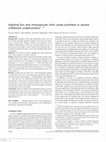
The American Journal of Clinical Nutrition, 2007
Background: Although nutritionally dispensable amino acids are not essential in the diet, adequat... more Background: Although nutritionally dispensable amino acids are not essential in the diet, adequate synthesis is necessary for maintenance of good health. Whereas children with edematous severe childhood undernutrition (SCU) can maintain production rates of glycine and serine despite a slower body protein breakdown rate, it is unknown whether the same is true for the semidispensable amino acid arginine. Objective: We aimed to measure arginine flux and intravascular nitric oxide synthesis in children with SCU. Design: Arginine flux and the fractional and absolute synthesis rates of plasma nitrite plus nitrate were measured postabsorptively by using a 6-h infusion of [ 15 N 2 ]-arginine in 2 groups of children with edematous (n ҃ 14) or nonedematous (n ҃ 7) SCU when they were infected and malnourished (postadmission day Ȃ3; clinical phase 1), when they were no longer infected (postadmission day Ȃ15; clinical phase 2), and when they were recovered (postadmission day Ȃ55; clinical phase 3). Results: Arginine flux was slower (P 0.01) and plasma arginine concentrations were lower in the edematous group than in the nonedematous group at clinical phase 1. At clinical phase 2, flux doubled to a value that was not significantly different from the value at clinical phase 3. There were no significant differences in the plasma concentration or fractional or absolute synthesis rate of plasma nitrite plus nitrate between the groups at any clinical phase and among clinical phases within each group. Conclusion: Whereas children with nonedematous SCU can maintain arginine flux at the same rate as when recovered, children with edematous SCU cannot. The slower arginine flux was not, however, associated with slower nitric oxide synthesis.
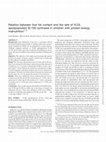
The American Journal of Clinical Nutrition, 2005
Background: Fatty infiltration of the liver is associated with an increased morbidity and mortali... more Background: Fatty infiltration of the liver is associated with an increased morbidity and mortality in children with severe proteinenergy malnutrition (PEM), but its pathogenesis remains unclear. Although impaired synthesis of VLDL apolipoprotein B-100 (VLDL-apo B-100) is generally accepted as the pathogenetic mechanism, the rate of it synthesis has not been measured in children with PEM. Objective: The objective of the study was to ascertain the relation between the degree of hepatic steatosis and the rate of VLDL-apo B-100 synthesis in children with PEM. Design: The fractional and absolute rates of VLDL-apo B-100 synthesis were measured with a prime-constant intravenous infusion of [ 2 H 3 ]leucine in 13 severely malnourished children (8 boys and 5 girls) aged 7-18 mo. Hepatic fat content was estimated by computerized tomography scanning by using the ratio of liver to spleen (L:S) attenuation. The ratio is inversely related to hepatic fat content such that the lower the L:S, the greater the amount of fat in the liver. Results: There were significant inverse relations between L:S attenuation and VLDL-apo B-100 concentration (P 0.02), the absolute rate of VLDL-apo B-100 synthesis (P 0.02), and plasma triacylglycerol (P 0.02) and serum cholesterol (P 0.05) concentrations. Conclusions: These results suggest that children with PEM synthesize VLDL-apo B-100 at a faster rate as the degree of hepatic fat infiltration increases. Thus, fatty infiltration of the liver in PEM is not due to a reduction in the synthesis of VLDL-apo B-100.
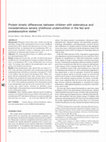
The American Journal of Clinical Nutrition, 2005
Background: Pathogenic factors that cause a child to develop the edematous instead of the nonedem... more Background: Pathogenic factors that cause a child to develop the edematous instead of the nonedematous form of severe childhood undernutrition (SCU) during food deprivation are not clear. It was hypothesized that, in edematous but not nonedematous SCU, impaired protein breakdown leading to inadequate amino acids for maintenance of important organ systems was a factor. Objective: We measured protein kinetics in children with edematous and nonedematous SCU. Design: Endogenous leucine flux, an index of whole-body protein breakdown rate, was determined in 4 groups of children with edematous or nonedematous SCU in the malnourished and recovered states. Two groups were studied in the postabsorptive state, and 2 groups were studied in the fed state. Results: In the postabsorptive state, leucine flux was slower (P 0.01) in the edematous group than in the nonedematous group in the malnourished state, but in the recovered state, it was faster (P 0.05) in the children who previously had edematous SCU. When compared with the malnourished state value, leucine flux at recovery doubled in the group that previously had edematous SCU, but it did not change in the other group. In the fed state, leucine flux was slower (P 0.01) in the edematous group than in the nonedematous group in the malnourished state but not in the recovered state. In the recovered state, enteral leucine extraction by splanchnic tissues trended higher in the group that previously had edematous SCU than in the nonedematous group. These findings indicate different protein breakdown responses to food deprivation between children with edematous and nonedematous SCU and inherent differences in protein metabolism when they have recovered.
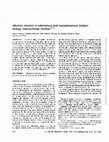
The American Journal of Clinical Nutrition, 1996
The kinetic changes responsible for decreased plasma albumin and the relation between plasma albu... more The kinetic changes responsible for decreased plasma albumin and the relation between plasma albumin and the edema of protein-energy malnutrition (PEM) were investigated by measuring the plasma concentration, fractional (FSR) and intravascular absolute (ASR) synthesis rates of albumin in seven edematous and seven nonedematous children with PEM by using constant intragastric infusions of [2H3]leucine. Studies were done 2 d postadmission (study 1), 8 d postadmission (study 2), and at recovery (study 3). In study 1 there were no significant differences in plasma albumin concentrations in nonedematous and edematous children. In both groups, albumin concentrations but not FSRs were lower in studies 1 and 2 than in study 3. The ASR was lower only in edematous patients. These results suggest that repletion of the albumin pool of children with PEM is not mediated by changes in the FSR, and the edema of malnutrition is not solely due to hypoalbuminemia.
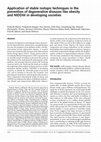
Food and Nutrition Bulletin, 2002
Economic development in developing societies characterized by idustrialization, urbanization, and... more Economic development in developing societies characterized by idustrialization, urbanization, and globalization has seen the emergence of an epidemic of diet- and life-style-related chronic degenerative diseases. A research project was initiated under the aegis of the International Atomic Energy Agency (IAEA), Vienna, Austria under its Coordinated Research Programme (CRP) to promote the use of stable isotopic techniques to document the extent of the problem and to understand the determinants of this epidemic. The principal objectives of this CRP involving countries both in the North and the South are to define the magnitude of the problem of obesity and non-insulin dependant diabetes mellitus (NIDDM) in developing countries, to identify the vulnerable groups at increased risk, and to attempt to describe the metabolic and physiological mechanisms underlying this phenomenon. These comparative international studies of obesity and NIDDM are looking at the effects of childhood malnutriti...
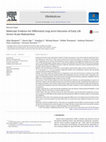
EBioMedicine, Jan 8, 2017
Severe acute malnutrition (SAM) in infants may present as one of two distinct syndromic forms: no... more Severe acute malnutrition (SAM) in infants may present as one of two distinct syndromic forms: non-edematous (marasmus), with severe wasting and no nutritional edema; or edematous (kwashiorkor) with moderately severe wasting. These differences may be related to developmental changes prior to the exposure to SAM and phenotypic changes appear to persist into adulthood with differences between the two groups. We examined whether the different response to SAM and subsequent trajectories may be explained by developmentally-induced epigenetic differences. We extracted genomic DNA from muscle biopsies obtained from adult survivors of kwashiorkor (n=21) or marasmus (n=23) and compared epigenetic profiles (CpG methylation) between the two groups using the Infinium® 450K BeadChip array. We found significant differences in methylation of CpG sites from 63 genes in skeletal muscle DNA. Gene ontology studies showed significant differential methylation of genes in immune, body composition, metabo...
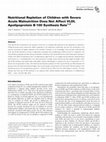
The Journal of Nutrition, 2012
VLDL apo B-100 is essential for the secretion of liver fat. It is thought that synthesis of this ... more VLDL apo B-100 is essential for the secretion of liver fat. It is thought that synthesis of this lipoprotein is impaired in childhood severe acute malnutrition (SAM), especially in the edematous syndromes, and that this contributes to the common occurrence of hepatic steatosis in this condition. However, to our knowledge, it has not been confirmed that VLDL apo B-100 synthesis is slower in edematous compared with nonedematous SAM and that it is impaired in the malnourished compared with the well-nourished state. Therefore, VLDL apo B-100 kinetics were measured in 2 groups of children with SAM (15 edematous and 7 nonedematous), aged 4-20 mo, at 3 stages during treatment. Measurements were done at 4 6 1 d postadmission, mid-catch-up growth in weight, and at recovery (normal weight-for-length). VLDL apo B-100 synthesis was determined using stable isotope methodology to measure the rate of incorporation of 2 H 3leucine into its apoprotein moiety. The fractional and absolute synthesis of VLDL apo B-100 did not differ between the groups or from the initial malnourished stage to the recovery stage. Concentrations of VLDL apo B-100 were greater in the edematous than in the nonedematous group (P , 0.04) and did not differ from the initial stage to recovery. The data indicate that VLDL apo B-100 synthesis is not reduced when children develop either edematous or nonedematous
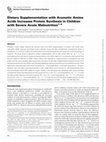
The Journal of Nutrition, 2014
Although 2 earlier studies reported that aromatic amino acid (AAA) supplementation of children wi... more Although 2 earlier studies reported that aromatic amino acid (AAA) supplementation of children with severe acute malnutrition (SAM) improved whole-body protein anabolism during the early postadmission (maintenance) phase of rehabilitation, it is not known whether this positive effect was maintained during the catch-up growth and recovery phases of treatment. This study aimed to determine whether supplementation with an AAA cocktail (330 mg Á kg 21 Á d 21 ) vs. isonitrogenous Ala would improve measures of protein kinetics in 22 children, aged 4-31 mo, during the catch-up growth and recovery phases of treatment for SAM. Protein kinetics were assessed by measuring leucine, phenylalanine, and urea kinetics with the use of standard stable isotope tracer methods in the fed state. Supplementation started at the end of the maintenance period when the children were clinically/metabolically stable and continued up to full nutritional recovery. Three experiments were performed: at the end of maintenance (at ;13 d postadmission), at mid-catch-up growth (at ;23 d postadmission when the children had replenished 50% of their weight deficit), and at recovery (at ;48 d postadmission when they had achieved at least 90% weight for length). Children in the AAA group had significantly faster protein synthesis compared with those in the Ala group at mid-catch-up growth (101 6 10 vs. 72 6 7 mmol phenylalanine Á kg 21 Á h 21 ; P < 0.05) and better protein balance at mid-catch-up growth (49 6 5 vs. 30 6 2 mmol phenylalanine Á kg 21 Á h 21 ; P < 0.05) and at recovery (37 6 8 vs. 11 6 3 mmol phenylalanine Á kg 21 Á h 21 ; P < 0.05). We conclude that dietary supplementation with AAA accelerates net protein synthesis in children during nutritional rehabilitation for SAM.
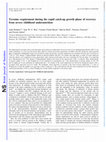
British Journal of Nutrition, 2010
The requirement for aromatic amino acids during the rapid catch-up in weight phase of recovery fr... more The requirement for aromatic amino acids during the rapid catch-up in weight phase of recovery from severe childhood undernutrition (SCU) is not clearly established. As a first step, the present study aimed to estimate the tyrosine requirement of children with SCU during the catch-up growth phase of nutritional rehabilitation using a diet enriched in energy and proteins. Tyrosine requirement was calculated from the rate of excretion of 13CO2 (F 13CO2) during [13C]phenylalanine infusion in thirteen children with SCU, five females and eight males, at about 19 d after admission when the subjects were considered to have entered their rapid catch-up growth phase and were consuming 627·3 kJ and about 3·5 g protein/kg per d. Measurements of F 13CO2 during [13C]phenylalanine infusion were made on two separate days with a 1 d interval. Three measurements at tyrosine intakes of 48, 71 and 95 mg/kg per d were performed on experimental day 1 and measurements at tyrosine intakes of 148, 195 and ...
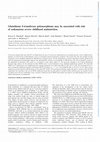
British Journal of Nutrition, 2006
It has been estimated that more than 50% of deaths before the age of 5 years have undernutrition ... more It has been estimated that more than 50% of deaths before the age of 5 years have undernutrition as an underlying cause. Severe childhood malnutrition, an extreme form of undernutrition, occurs as oedematous and non-oedematous syndromes. The reasons why only some children develop oedematous severe childhood malnutrition (OSCM) have remained elusive, but the heterogeneity of clinical appearances among children from relatively homogeneous backgrounds suggests that interindividual variation in susceptibility to OSCM may exist. We investigated variants of four glutathione S-transferase (GST) genes in a retrospective study among subjects (n136) previously admitted to the Tropical Metabolism Research Unit, Jamaica, for the treatment of either OSCM (cases) or non-oedematous severe childhood malnutrition (controls). We found that GSTP1 Val105 homozygotes were significantly more common among the cases (odds ratio (OR) 3·5; 95% CI 1·1, 10·8). We also found an association of borderline signifi...
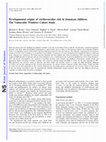
British Journal of Nutrition, 2010
Both intra-uterine and early childhood development contribute to the risk of developing CVD in ad... more Both intra-uterine and early childhood development contribute to the risk of developing CVD in adult life. We therefore evaluated the maternal, placental, fetal, birth, infant and childhood determinants of cardiovascular risk in a cohort of Afro-Jamaican children. The Vulnerable Windows Cohort is a longitudinal survey of 569 mothers and their offspring recruited from the first trimester. The offspring's anthropometry was measured at birth, at 6 weeks, every 3 months to 1 year and then every 6 months. At mean age 11·5 years, fasting blood was sampled for glucose, insulin and lipids. Analyses were confined to 296 women and their offspring who had complete data. Waist circumference (WC) was related to maternal weight and BMI, placental weight and to the size of the offspring in utero, at birth and the rate of growth in childhood (P < 0·05). Total cholesterol, TAG and glucose concentrations were unrelated to maternal, placental, fetal, neonatal and childhood measurements. Fasting...









Uploads
Papers by Terrence Forrester